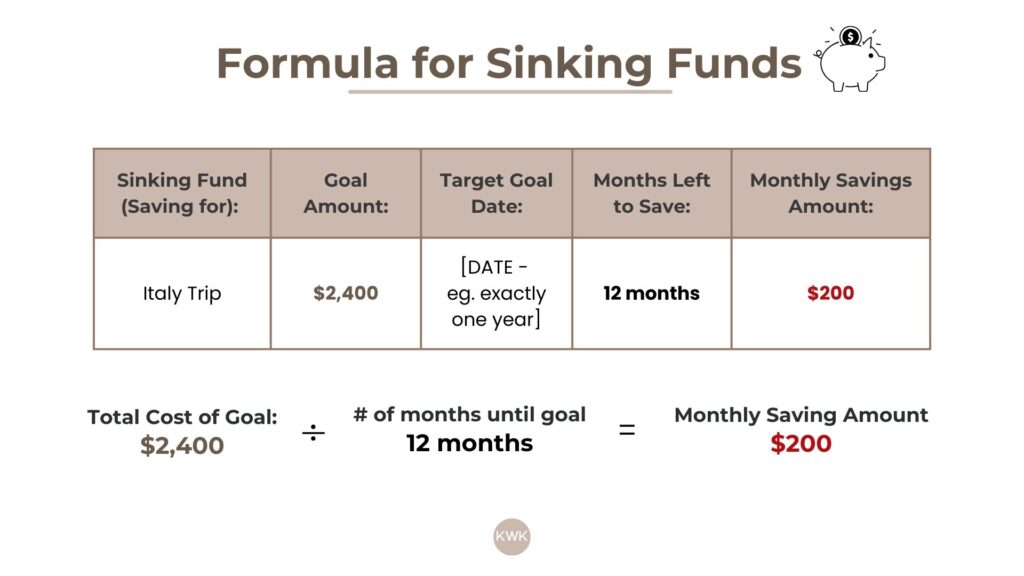Do planned expenses ever feel like they just sneak up on you, even when you’ve been expecting them? Think holiday season shopping, your upcoming vacation, or that car down payment that you knew about months ago?
To avoid getting into any money trouble for these planned expenses, creating sinking funds is the solution.
What is a Sinking Fund?
Sinking funds function like mini savings accounts where you consistently set aside money over time for larger, anticipated expenses. This way, when the expense arrives, you have the funds readily available, avoiding the stress of potentially going into debt.
Unlike emergency funds, which provide a safety net for unexpected events like job loss or medical bills, sinking funds are specifically designed for saving up for planned, larger expenses expected within the next 2-3 years.
Want to Make Sinking Funds Simple? Check out this Sinking Fund Tracker Google Sheets. This tool takes the guesswork out of saving, automatically calculates how much to save, and tracks your progress—all in one place!
![]()
Benefits of Sinking Funds:
Sinking funds offer numerous benefits beyond simply avoiding debt. Here are some key advantages to consider:
- Peace of Mind: Knowing you have dedicated funds for specific goals reduces financial stress and helps you handle unexpected expenses without derailing your budget.
- Financial Discipline: Sinking funds encourage consistent saving habits, giving you more control over your finances.
- Goal Achievement: Allocating dedicated funds helps you reach your savings goals faster rather than just relying on occasional deposits to your savings account.
- Increased Motivation: Tracking your progress in your sinking funds is incredibly motivating! Seeing your savings grow keeps you focused and excited about achieving your goals.
Examples
Now, let’s explore some real-life examples to see how they can help you save for various planned expenses and avoid financial strain.
- Holiday Budgeting: Dreading the overwhelming expenses of the holiday season? A designated ‘Holiday Gifts’ sinking fund allows you to save a set amount each month throughout the year. Come November, you’ll have a comfortable cushion to purchase presents without falling into debt.
- Travel Fund: Dreaming of your next vacation? A ‘Travel fund’ allows you to save for your next trip. This way, you can avoid credit card debt and fully enjoy your well-deserved getaway.
- Car Repairs: Cars are notorious for unexpected repairs. Setting up a “Car Repair” fund ensures you have readily available money to cover these costs, preventing financial setbacks.
- Home Down Payment: Dreaming of buying a house? A ‘Down Payment fund’ allows you to save consistently towards this goal. Tracking your progress keeps you motivated and prepared for the home buying process.
- Home Improvement: Owning a home can be rewarding, but unexpected repairs can arise. A ‘Home Improvement’ fund allows you to save for these potential costs, ensuring you’re prepared for anything from leaky faucets to roof replacements.
Sinking funds aren’t limited to these examples! Sinking funds can be tailored to any goal you want to achieve within the next 2-3 years. Think birthdays, annual subscriptions, a new course, or even that hobby you’ve been wanting to try out!
Getting Started with Sinking Funds: A Step-by-Step Guide
Sinking funds are a simple and effective way to save for planned expenses. Here’s how to get started:
- Identify Your Saving Goals: List your upcoming planned expenses– a new phone, holiday gifts, a house down payment, or next vacation. Be specific!
- Set Your Amount Goal: Research and calculate how much you will need for each planned expense. Getting a realistic idea of the cost will help you determine your savings goals.
- Set Your Target Goal Date: Determine when you’ll need the money and how long you have to save. Knowing your starting date and target date will help you determine your monthly contribution amounts.
- Set Your Monthly Savings Amount : For each expense, divide the total cost by the number of months until the expense occurs. This will be your monthly savings amount. Make sure it’s an amount you can comfortably contribute towards each sinking fund each month. You can allocate a fixed amount from your paycheck or set up automatic transfers to ensure consistent saving.
- Track Your Progress: Monitor your progress regularly to stay motivated and reach your goal. Use budgeting apps, spreadsheets, digital budget planner, or a simple pen-and-paper planner to track your funds easily.

Ready to Start Saving?
See how to use the steps above to create your own sinking funds in just one minute. Watch this quick video to get started!
Feeling Overwhelmed? Let the Tracker Do the Work for You!
Forget the math and manual tracking. With the Sinking Fund Tracker Google Sheets, you’ll have everything you need to create a plan, stay organized, and hit your savings goals without the stress.
👉 Grab Your Tracker Here
Practical Tips for Managing Sinking Funds
- Realistic Goals: Start with achievable goals and contribution amounts. It’s better to start small and gradually increase your contributions than set unrealistic expectations and get discouraged.
- Give your Goal a Name: Give your sinking funds descriptive names to stay motivated.
- Pick a Secure Storage Location: Decide where to store the money you allocate towards your sinking funds. High-Yield Savings Accounts (HYSAs) are a popular option as they typically offer higher interest rates and security for your money. Learn more about HYSAs and their benefits here.
- Integrate with Your Budget: Allocate a specific amount from your budget towards each sinking fund on a regular basis (weekly, bi-weekly, monthly).
- Automated Savings: Set up automatic transfers from your checking account to your sinking funds. This removes the temptation to spend that money and ensures consistent progress.
- Regular Review: Review your progress regularly and adjust your contribution amounts if necessary because we all know life happens! Celebrate milestones to stay motivated and on track.
Conclusion:
Sinking funds are a powerful tool for taking control of your finances and achieving your financial goals. By implementing the steps and tips outlined in this guide, you can empower yourself to start reaching your saving goals. Remember, small, consistent steps lead to big results!
Have any questions about Sinking Funds? Leave a comment below and let’s chat!
Ready to Start Saving Smarter?
Don’t let another year go by without a clear savings plan. Grab the Sinking Fund Tracker Google Sheets now and take the first step toward achieving your saving goals.
Want a free, downloadable budget template to get a clearer picture of your finances? Check it out here.

